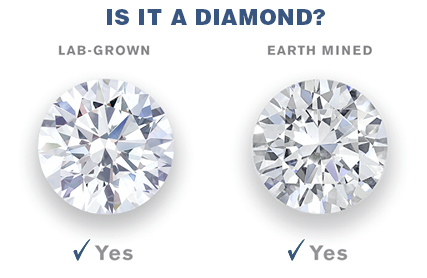Lab-created diamonds, also known as engineered or cultured diamonds, are grown in highly controlled laboratory environments using advanced technological processes that duplicate the conditions under which diamonds naturally develop when they form in the mantle, beneath the Earth’s crust. These lab-created diamonds consist of actual carbon atoms arranged in the characteristic diamond crystal structure. Since they are made of the same material as natural diamonds, they exhibit the same optical and chemical properties.


What Is A Lab-Grown Diamond?
The first aspect that jumps out when comparing natural diamonds to lab-grown diamonds is the cost difference: Lab-grown variants allow you to save significantly on your engagement ring or jewelry, reducing the cost by up to 40% when considered versus comparable naturally occurring diamonds.
This means you can opt for a larger, higher-quality stone and still end up saving money. Additional benefits of lab-grown diamonds include:
- Lab-grown diamonds are ethical, sustainable, and conflict-free. Since they are grown in a lab, these diamonds do not harm the environment through mining or contribute to human rights violations (“blood diamonds”).
- They are comparable in looks and structure to a naturally-formed diamond. Even skilled gemologists can have a difficult time telling a lab-grown and natural diamond apart.
- Lab-grown diamonds are much more affordable, especially rare colored diamonds like pink, so you can get a bigger diamond and save.
- They can easily make matching stones, unlike natural diamonds which can be difficult to match.
Lab-Grown Diamonds Vs Natural
There are two primary processes that are used to build lab-grown diamonds: High-Pressure, High-Temperature, and Chemical Vapor Deposition. Saettele is a St Louis jeweler that has expertise in lab-grown diamonds.
HPHT is the older of the two methods, having been developed in the 1950s, whereas CVD is a much more recent process and is now considered the preferred method of growing diamonds.
- High-Pressure, High-Temperature Technique – A diamond “seed” is subjected to extremely high pressures and temperatures, just like a natural diamond would experience. This method can be used to increase the quality of natural diamonds.
- Chemical Vapor Deposition Technique — A chamber is filled with a carbon-rich vapor and the carbon atoms are extracted and deposited onto a diamond crystal wafer, which grows the diamond layer by layer. This method requires less heat/pressure and allows for more control over the growing environment, which is why it is becoming the preferred growth method.
As technological advances have improved the process for growing diamonds, the finished product has become indistinguishable from natural diamonds. In fact, even certified gemologists often cannot tell them apart.
If you are looking for a diamond engagement ring or any other piece of diamond jewelry, it is definitely worth considering a lab-grown diamond. You will get an equally beautiful, sustainable diamond for a significantly reduced cost.

Get In Touch With Saettele!
Enter your information below or call 314-725-8182 to get in touch with a Saettele representative.



